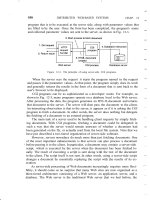head first java second edition phần 9 ppsx
Bạn đang xem bản rút gọn của tài liệu. Xem và tải ngay bản đầy đủ của tài liệu tại đây (3.2 MB, 68 trang )
16
collections and generics
Data
structures
Sorting is a snap in Java. You have all the tools for collect ing and manipulating
your data
without
having to write your own sort algorithms (unless you're reading this right
now sitting in your Computer Science 101 class,in which
case,
trust
us-you
are
SO
going to be
writing
sortcode while the rest of us Justcall a method In the JavaAPI). The
Java
Collections
Framework has a data structure that should work for virtually anything you'll ever need
to
do.
Want to keep a list that you can easily keep adding to? Want to find something by name?Want
to create a list that automatically takes out all the duplicates?
Sortyour co-workers by the
number of times they've stabbed you in the back?Sort your pets by number
of
tricks learned?
It'sall here
this is a new
chapter
529
sorting
a
list
fracki"Q
SOt1g
popularity
0.,
your
jukebox
Congratulations
on
your
new job man
aging
the
automated
jukebox
system at
Lou
's
Diner
.
There's
no Javainside
the
jukebox
itself,
but
each
time
someone
plays a song,
the
song
data
is
appended
to a simple text file.
Your
job
is to
manage
the
data
to track
song
popularity,
generate
reports,
and
manipulate
the playlists, You
're
not
writing the
entire
ap~ome
of
the
other
software
developer/
waiters
are
involved as well.
but
you're
responsible for
managing
and
sorting
the
data
inside
the
java
app
.
And
since Lou has a
thing
against databases, this is strictly an
in-memory
data
collection. All
you
get
is
the
file
the
jukebox
keeps
adding
to. Your
job
is to take it
from
there.
You've already figured
out
how to
read
and
parse
the
file,
and
so far
you've
been
storing
the
data
in
an
ArrayList.
SongLlst.
txt
Pink
Moon/Nick
Drake
Somersault/Zero
7
Shiv&
Moon/Prem
Joshua
Circles/BT
Deep
Channel/Afro
Celts
Passenger/Headmix
Listen/Tahiti
80
530
chapter
16
Challenge
#1
Sort
the
songs in
alphabetical
order
You have a list
of
songs in a file.
where
each line
represents
one
song
,
and
the
title
and
artist
are
separated
with a forward slash. So it
should
be simple
to parse
the
line,
and
put
all
the
songs in an ArrayList.
Your boss cares only
about
the
song
titles, so for now
you can simply
make
a list
that
just
has
the
song
titles.
But
you can
see
that
the
list is
not
in alphabetical
order
what can you do?
You know
that
with an Arrayl.ist,
the
elements
are
kept
in
the
order
in which they were
inserted
into
the
list,
50
putting
them
in an ArrayList
won't
take care
of
alphabetizing
them,
unless maybe
there's
a
sortj)
method
in
the
ArrayList class?
collections
with
generics
Here's
what
you
have
so
far;
without
the
sort:
impo4t
java.util.*;
import
java.io.*;
pUblic
class
Jukeboxl
ArrayList<String>
songList
: new
ArrayList<String>()
i
catch(Exception
ex)
(
ex.printStackTrace();
public
static
void
main
(String
()
args
1 I
new
Jukeboxl()
. ge ( ) ;
public
void
go()
I
~
getSongs();
System.out.println(songList);
.
1:
Y'tilO
the t
'lle
il"d
Not.hi,,~
syet."lill
he
e
J~oo
~a
eat"
\il'le·
void
gatSonqa
()
t.a\\
-\:.he
ilod$of ~O
'"
try
{
File
file
new
File("SongList.txt
H
) ;
BufferedReader
reader
= new
BufferedReader(new
FileReader(file»:
String
line
=
null;
whi
Le «
line=
r e
ade
r ,
readLine
() ! =
null)
(
addSong(line);
The
tiddSon
Ci
d j th 1
"'eiJ od
\\/orh
.
r
(J
-J
Ln.
e I/O thdpU
JIISf
likl!
i~1!
/.I "
~"t;
Ild$
both
th tifl
y
Ok
b
k
"i'l<lz
void
addSong(Strinq
lineToParse)
I
pieCes
(MOu)
lotS'
I!
ill!
tlnd
i1r-t.i:tJ
.tt
}itle
String
(1
tokens
=
lineToParse.
split
("/")
;
"\5
tht!
spliiO
"'eih;.
two
songList.add(tokens[Ol);
<:
%j ava
Jukebox!
[Pink
Moon,
Somersault,
Shiva
Moon,
Circles
,
Deep
Channel,
Passe
nger ,
Listen}
you are
here.
531
Array
List
API
~ut
the
ArrayList
class
does
NOr
have
a
sartO
tMethod!
When you
look
in Arrayl.isr,
there
doesn't
seem
to be any
method
related to sorting.
NaJking
up
the
inheritance
hierarchy
didn't
help
either-i
t's
clear
that
y()U
can't call a
sort
nethod on the ArrayList.
•
-
• 1•
,.,
AW I.1a.aC~
.1UlI
. . r- -
-
-
==:::::==
==-
-i
!IDt>nu
t.n.<l lf lhil lUI
~
iIl£spedIDI ,
.&
regu
(
l rl
t.
Ic
gaJ r:
us _,
at. lA:ItlWl
,.
~>es
fltJa>
!hi>
USl
all
~
~
dcm<lll
I; I
ftlW.1.a
.
~
• .L1&WRL
l!UIt,Ulor
,
~7l f
••
~
-C;.
-::T~
A;ii'iVUi
t
(Jiiii
2
Pli"tfOOii
sr 5:0)
~
i:i)11e
rn
+
lf
~
h
It
P
:
1/
J
av
LS
u
n
.
ro
m
/
J
1
n
/
l
.
S
.
O
'
docs
/
&pl
/
l
n
cl
tx
.
h
l
m
l
cha
p
ter
16
~
TreeSet
Keeps
the
elements
sorted
and
prevents
duplicates
.
r do
see
a collection class
celled
TruSe.t
and
the
docs
sCI>!
that
it
keeps your
data
sorted.
r wonder
if
r should be
using a
TreeSet
inste.ad of an
ArrayList
o
o
collections
with
generics
ArrayLisf
is.!Q1
the
ot1ly
collectiot1
Although ArrayList is the
one
you'll use
most
often,
there
are
others
for special occasions.
Some
of
the
key .
collection classes include: D
't
'NcKY'f
C1nOl>t
b-'tl~
Of'
~ese
oth~
Ol'Ies
t.o
\eClyY\
'\I 0 il'l-to
yiaht
"0
·
We
~c
,1._
~e
o~il~
a
\iH:le
C1~'
HashMap
Let's
you
store
and
access
elements
as
namelvalue
pairs.
~
L1nkedLlst
Designed
to
give
better
performance
when
you
insert
or
delete
elements
from
the
middle
of
the
collection.
(In
practice,
an
ArrayUst
is
still
usually
what
you
want.)
~
HashSet
Prevents
duplicates
in
the
collection,
and
given
an
element,
can
find
that
element
in
the
collection
qulcldy.
~
L1nkedHashMap
Like
a
regular
HashMap,
except
it
can
remember
the
order
in
which
elements
(name/value
pairs)
were
Inserted,
orit
can
be
configured
to
remember
the
order
In
which
elements
were
last
accessed.
you are here
~
533
Collectlons.sortO
You
could
use
a
freeSet.
Or
you
could
use
the
Coliectiotts.sortCl
tttethod
lava.utll.collections
publicstaticvoid copy{Ust destination.
List
source)
publicstaticUst
emptyUst()
publicstaticvoid flll(List
IIstToFill,
ObjectobjToFillltWrth)
public staticInttrequency(Collection c, Object
0)
publicstaticvoid
reverse{Ust
list)
publicstaticvoid rotate(Ust
list,
lnt distance)
publicstaticvoid
shuffle(Ust
list)
publicstatic
~
sOrt{L\st
listV
.
;~.
II".
Ohiect
oIdVal,
Object
newVal)
public
static
boole
/Imany
more
met
.ij",
,,,,,,
!here
IS
a sor!()
Meihod
I-
-
~
1ft
!he
Collet-t;ofts
tlass.
I! hkes
a Lis!
and'
A
nd1
'
Slftte
rrayList
i"'ple_e
i.s
!he Lis! . t +
er ate,
rrayLlst
ArrayLis!
IS-A
Lis!.
Thanks
verloaded
!o
polyMorphisM,
y~
tan
pass
a
ckly as calling
~rayList
to a
Me!hod
d ,
nt at
the
end.
to ta
et
ared
't need to
put
Ice
List
A:
Yes,
It's slower to insert something in an A
somewhere
otherthan at
the
end. So using
the
0
add(lndex, element)
method
doesn't
work
as qui
the
add(element)-which
puts
the
added eleme
But most of the
time
you use ArrayLists, you
won
something at a specific Index.
lfyou
put
all
the
Strings (the
song
titles)
into
a
TreeSet
instead
of
an ArrayList,
the
Strings would automatically
land
in
the
right
place,
alphabetically
sorted.
Whenever
you
printed
the
list,
the
elements
would
always
come
out
in
alphabetical
order.
And
that
's
great
when
you
need
a set (we'll
talk
about
sets in a few
minutes)
or
when
you know
that
the list
must
au.vays
stay
sorted
alphabeticall
y.
On
the
other
hand,
if
you
don't
need
the
list to stay
sorted.
TreeSet
might
be
more
expensive
than
you
need-every
timeyou
insertinto a
Treeset;
the
TreeSet
has to take
the time to
figure
out where in 1Mtreethe
new
element
must
go.With ArrayList, inserts
can
be
blindingly fast
because
the
new
element
just
goes
in
at
the
end
.
Q: But you
CAN
add
something
to an
ArrayList
at
a specific Index Instead of just at
the
end-there's
an overloaded addll method
that
takes
an Int along
with
the
element
to
add
So wouldn'fft
be
slower
than
Inserting
at
the
e
Q: I
see
there's a L1nkedllst class,sowouldn't that
be
better
for
doing
Inserts
somewhere
In
the
middle1 At least if I
remember
my Data
Structures class from college
A:
Yes,
good
spot. The LinkedLlst canbe quicker
when
you Insert or
remove something
from
the
middle,
but
for most applications,
the
difference
between
middle
inserts Into a
Linkedllst
and ArrayList is usually
not
enough
to care
about
unless you're dealing
with
a huge
number
of elements. We'll
look
more at L1nkedLlst In a few minutes.
534
chapter
16
collectlons with generics
Addit1g
Coliectiot1s.sortU
to
the
Jukebox
code
impo r t j a
va
. ut i l .*;
im
port
java
. i o .
T
;
publ i c cl as s Jukeb oxl
ArrayList<String>
songList
= new
ArrayList<String>();
pub
lic
s t a t i c voi d mai n (
St
ri
ng [] a r gs) (
new
Jukeb
ox1 () .go
();
The
Collections.sortO
lllethod
sorts
a
list
of
StriPgs
alphabetically.
pub
lic
voi d
got)
r
ge
r-
Song s () ; 1t.aVt.
CoI\et
:b~
S
yste
m.
out
. p
ri
nt l n (s ongLi
st
) ;
~
~~~et\<'odl
~e"
Y'f\,,~-\;.h~
Collections.
sort
(songList)
; \' L ,
"T"
ne
~[t.ot>d
~,,,t.
,5<.
a~''''
\ J I
System.out.println
(songList)
;
~
'IS
,,,
i\,,~'oebt.a\
cJt"~t:'t'.
voi d
getsongs
()
t r y (
Fi
l e ll e new Fi l e ("SongLi s t . t xt
H
) ;
Buffer
edRea
de
r r eader = new Buf fe r edR
ea
der (new
FileRe
a
de
r (fi
le
» ;
St r i ng
li
ne - nu l
l;
wh
il
e ( (
li
n
e-
r e a de r i r e
adt.L
ne t ) l !='
null)
(
addSong
(1
i ne ) ;
ca
tc
h (E
xc
ep
tio
n
ex)
(
ex.printS
a c kTr a c e ( ) ;
voi d
addSong(String
lineToParse)
(
tr
i
ng
l ]
to
ke ns = l i ne T
oP
a r s e . s p l i
t(
" /H ) ;
son
gList
.r.tdd (
to
ken.s
[O
] ) ;
%j ava
Jukeboxl
[Pink
Moon
,
Somersault,
Shiva
Moon,
Circles,
Deep
Channel
,
Passenger
,
Listen)
(Circles,
Deep
Channel,
Listen,
Passenger,
Pink
Moon
,
Shiva
Moon,
Somersault]
•
,
you
are
here
~
535
sorting
your
own objects
Jut
now
you
Meed
SOMQ
objects,
not
just
shttple
Stri"Qs.
Now your boss wants actual Song class instances in
the
list,
not
just
Strings, so
that
each
Song
can have
more
data.
The
new
jukebox
device
outputs
more
information, so this time the file will have
four
pieces (tokens) instead
of
just
two.
The
Song class is really simple, with only
one
interesting
feature-
the
overridden toStringO
method.
Remember, the toString()
method
is defined in class Object, so every class
inJava
inherits
the
method. And since the taStringO
method
is called on an object
when it's
printed
(System,out.println(an Object) ), you
should
override it to
something
more readable than
the
default
unique
identifier code.
When
you
a list. the toStringO
method
will be called on each object.
class
Song
(
String
title;
f
String
artist;
String
rating;
String
bpmi
Song(String
t,
String
a,
String
r,
String
b) (
title
=
t;
artist
='
a;
The
va~i.ables
a t all sd.
i"
rating
=
r;
the
l.or\strl.ll.i«
wher>
the
bpm = b r "
I\ew
~,,~
is
l.~eated
,
SongUstM0r2.
txt
Pink
Moon/Nick
Drake/5/80
Somersault/Zero
7/4/84
Shiva
Moon/Prem
Joshua/6/120
Circles/BT/5/110
Deep
Channel/Afro
Celts/4/120
Passenger/Headmix/4/l00
Listen/Tahiti
80/5/90
pUblic
String
getTitle()
return
title;
public
String
getArtist()
return
artist;
public
String
getRating(}
return
rating;
public
String
getBpm()
return
bpm;
public
String
toString
()
return
title;
536
chapter
16
imp
or
t j
ava
.
ut
i l . * ;
imp
o
rt
ja
v
a.i
o.*;
collections
with
generics
Changing
the
Jukebox
code
to
use
Songs
instead
of
Strings
Your
code
changes only a
little-the
file
I/O
code
is
the
same,
and
the
parsing is
the
same (String.splitf)).
except
this time
there
will be Jourtokens
for
each
song/line,
and
all
four
will be
used
to
create
a new Song object.
And
of course
the
ArrayList
will be
of
type <Song> instead
of
<String>.
L
A.rra'JL.ist
cJ
SoY\~
Chan~e
~
an
f\
J
'Stv
:ln~.
objetts
Instead
publi
c c l a s s
J
UkebOX
~
~
ArrayList<Song>
songList
= new
ArrayList<Song>();
pu
bl
i c
stati
c voi d mai
n(
S
tr
i n
g[
]
ar
g
s)
(
ne
w J u
ke
b
ox3()
. g o () ;
}
pu
b l i c
void
ge()
{
ge
tSo
n
gs()
;
Sy
st
em. out . p
ri
nt
ln(
s ong Li s
t)
;
C
ol
lec
t i ons
.sor
t(so
ngLi s t ) ;
Sys
tem
.
out
.pr
i
nt
l n
(s
ongLis
t ) ;
}
vo
id
getSongs
()
try
{
Fi
le
fil
e new
Fil
e{"
Son
gLi s t . t
xt
H
) ;
Buffered
Rea
der
r e
ade
r = ne vi Bu
ffe
r ed Re
ad
e r (ne w F
ile
R
ea
d
er
(fil
e ) ) ;
St r i ng
lin
e =
nu
l l ;
wh
il
e «
Li
ne
> r e a de r .
re
a
dLin
e (
))
!
~o
n
ull)
(
a dd
Song
(
lin
e ) ;
catch
(E
xce
p
ti
on e x)
e x
.pr
i
ntStackTra
c e () ;
vo
id
addSeng(String
lineTeParse)
{
St
ri
ng [] t
okens
=
line
ToPa r s e .
spl
it("
/"
);
Song
nextSonq
= new
Sonq(tokens[O]
,
tokens[l],
tokens
[2]
,
tokens[3]);
songList.add(nextSong);
you
are
here
~
537
Collections.s0
rtO
It
WOt1~t
cotMpi
Ie!
Something's
wrong
the
Collections class clearly shows
there's
a
sort/)
method,
that
takes a List.
ArrayList is-aList, because ArrayList
implements
the
List interface,
so it
should work.
But it doesn't!
The
compiler
says it
can't
find a
sort
method
that
takes an
Arrayl.istc'Songo, so maybe it
doesn
't like an Arrayl.ist
of
Song
objects? It
didn't
mind
an ArrayList<String>. so what's
the
important
difference between
Song
and
String? What's
the
difference that's
making
the
compiler
fail?
%javac
Jukebox3.java
JukeboK3
.java:15
:
cannot
find symbol
symbol method
sort(java
.util.ArrayList<Song»
location:
class
java.util
.Collections
Collections.sort(songList);
1
error
And
of
course
yOll
probabl
y already asked yourself, "What would it
be
sorting
onr How would
the
sort
method
even know what
made
one
Song
greater
or
less
than
another
Song? Obviously
if
you want
the
song's titleto be
the
value that
determines
how
the
songs
are
sorted, you'll
need
some
way to tell the sort
method
that it
needs
to use the title
and
not,
say,
the
beats
per
minute.
We'll
get
into
aU
that
a few pages from now,
but
first, let's find
out
why
the
compiler
won 't even let us pass a
Song
ArrayList to
the
sortt)
method
.
538
chapter 16
collections
with
generics
WID
I have no idea how to
read
the
method declaration
on this.
It
says
that
sortO
takes
a
List~T)
.
but what is
n And what is
that
big thing
before
the
return
type?
o
o
fhe
sortO
tMethod
declaratiot'
sort
public:
at.4t~
fUl.teDd:
eome:rllbl&<?
auper
T>";>Oid
.o~
HlStl
Sortsthe
specified
listinto
ascending
order.
according
to
the
nalJITal
ordering of its elements. All
elements in the list mu.st
implement
the
Comparable
interface.
Furthermore.
all elements in the list
must
be mullllllJy
comparab~
(that is,
el.cOIIlpareTo
I
82)
must not
throw
a
ClaasC4st
.E>l:c:eption
for
any
elements&1 and
82
in the list).
From
the
API
docs (looking up
the
java.util.Collections class.
and
scrolling to
the
sortt)
method),
it looks like
the
sortt)
method
is
declared
strangely
.
Or
at
least different from
anything
we've seen so far.
That's
because the
sortO
method
(along with
other
things in
the
whole collection framework in
Java) makes heavy
use
of
generics.
Anytime you see
something
with
angle
brackets
inJava
source
code
or
documentation,
it
means
generics
-a
feature
added
to Java 5.0. So it looks like we'll
have to
learn
how to
interpret
the
documentation
before we can figure
out
why we were able to
sort String objects in an
Arrayl.ist,
but
not
an ArrayList
of
Song
objects.
you are here
~
539
generic types
&et1erics
",eat1s
",ore
type
safety
We'lljust
say it
right
here-virtually
all ofthe
code
you writethat
deals
with
generi
cswill be
collection-related
code
.
Although
generics
can
be
used
in
other
ways,
the
main
point
of
generics is to
let
you write type-safe
collections.
In
other
words,
code
that
makes
the
compiler
stop
you
from
putting
a
Dog
into
a list
of
Ducks.
Before generics (which
means
before
Java 5.0),
the
compiler
could
not
care
less
what
you
put
into
a collection, because all collection
implementations
were
declared
to
hold
type Object. You
could
put
anything in any ArrayList;
it
was like all ArrayLists were
declared
as
ArrayList<Object>.
ArrayList
~
~ ~
~
••••
And
come
OUT
as
a
reference
of
type
Object
wIth
generics.
you
can
create
type-safe
collections
where
more
probleltlS
are
caught
at
compile-time
inStead
of
runtil1le.
wIthout
generics.
the
compiler
would
happily
let
you
put
a
Pumplin
into
an
ArrayLiSt
that
was
supposed
to
hold
only
Cat
objects.
ArrayList<Fish>
WITH
generics
Objects
go
IN
as
a
reference
to
only
Fish
objects
And
come
out
as
a
reference
of
type
Fish
540 cha
pter
16
Learning
generics
Of
the
dozens
of
things
you
could
learn
about
generics
,
there
are
really
only
three
that
matter
to
most
programmers:
•
Creating
instances
of
generified
classes
(like
Array
List)
When
you
make
an
Arra
yList,
you
have
to tell it
the
type
of
objects
you
'll allow
in
the
list
,just
as
you
do
with
plain
old
arrays.
•
Declaring
and
assigning
variables
of
generic
types
How
does
polymorphism
really
work
with
generic
types?
If
you
have
an
ArrayList<Animal>
reference
variable,
can
you
assign
an
Arra
yList<Dog> to it?
What
about
a List<Animal>
reference?
Can
you assign
an
ArrayList<Animal> to it? You'll see
•
Declaring
(and
invoking)
methods
that
take
generic
types
If
you
have a
method
that
takes as a
parameter,
say,
an
ArrayList
of
Animal
objects,
what
does
that
really
mean?
Can
you
also pass it
an
ArrayList
of
Dog
objects? We'll
look
at
some
subtle
and
tricky
polymorphism
issues
that
are
very
different
from
the
way
you
write
methods
that
take
plain
old
arrays.
(This is actually
the
same
point
as #2,
but
that
shows
you
how
important
we
think
it is.)
Q.:
But
don't
Ialso
need
to learn how to
create
my
OWN
generic
dasses?
What if I
want
to make a class
type
that
lets people
instantiating
the
class decide
the
type
of things
that
class will use?
A.:
You probably
won't
do much
of
that.Think
about
it-the
API
designers made an entire library
of
collections classescovering most of
the data structures you'd need,and virtually the
only
type
of
classes
that
really need to be generic are collection
classes.
In other words,
classes
designed to hold other elements, and you want programmers using it to
specify what
type
those elements are when
they
declare and instantiate
the collection class.
Yes,
it is possible
that
you
might
want
to
create
generic
classes,
but
that's
the exception, so we won't cover it here. (But you'll figure it
out
from the
things we
do cover,anyway.)
collections with generics
new
ArrayList<Song>()
List<Song>
songList
=
new
ArrayList<Song>()
void
foo(List<Song>
list)
x.foo(songList)
you
are
here
~
541
generic
classes
Using
generic
CLASSES
Since ArrayList is
our
most-used generified type, we'll
start by looking at its
documentation.
They two key areas
to
look
at in a generified class
are
:
1)
The
class
declaration
3)
The
method
declarations
that
let
you
add
elements
Understanding
ArrayList
documentation
(Or,
what's
the
true
meaning
of
"E"?)
public
class
ArrayList<E>
extends
AbstractList<E>
II
more
code
The
"E" represents
the
type
used
to
create
an instance
of
ArrayList.
When
you see
an
"E" in
the
ArrayList
documentation
, you
can
do
a
mental
find/replace
to
exchange
it
for
whatev
er
<type> you use to instantiate
ArrayList.
So, new ArrayList<Song> means
that
"E" becomes "Song",
in any
method
or
variable declaration
that
uses "E".
542
chapte r 16
Thinl
of
"E"
as
a
stand-in
for
"-the
type
of
e
lem.ent
you
want
this
collection
to
hold
and
return."
(E
is
for
Elenent.)
- -
implements
List<E>
, {
.:
The t'tfe (the
lJal~
of
<f.»
bet.oMes
the
t'fVe
of
the List
il'ltel""kat.e
as
well
.
collections
with
generics
Usit1Q
type
parattteters
with
ArrayList
THIS
code:
ArrayList<String>
thisList
=
new
Means
ArrayLlst:
. {
public
boolean
addlE
0)
/ /
more
code
Is
treated
by
the
complier
as:
public
class
ArrayList<Strinq>
extends
AbstractList<Strinq>
.
{
public
boolean
add(Strinq
0)
/ /
more
code
In
other
words,
the
~E~
is
replaced
by
the
realtype (also called
the
type
parameter)
that
you use when you create
the
Arrayl.ist,
And
that's why
the
add
0
method
for ArrayList
won't
let you
add
anything
except
objects of a reference type that's
compatible with
the
type of
~E
".
So
if
you make an ArrayList<:String>,
the
add
0
method
suddenly becomes
add
(String
0).
!fyou
make
the
ArrayList of type Dog,
suddenly the addt)
method
becomes
add
(Dog
0).
Q: Is"E"
the
only thing you can
put
there18ecause
the
docs for sort used
"1'':'
•••
A:
You can use anything that's a legal Java Identifier. That means anything that you
could use
for
a method or variable name will
work
as a
type
parameter. But the conven-
tion
Is to use a single letter (so that's
what
you should use),and a
further
convention
IS
to
use
MT"
unless you're specIfically wrltlng a collection class,where you'd use
ME"
to repre-
sent
the
"type
of the Element the collection
will
hold"
you
ar
e here )
543
generic
methods
A generic
class
means
that
the
class
declaration
includes a type
parameter. A generic
method
means
that
the
method
declaration
uses a type
parameter
in its signature,
You
can
use type parameters in a
method
in several different
ways:
•
Using
a
type
parameter
defined
In
the
class
declaration
public
class
ArrayList<E>
extends
AbstractList<E>
(
public
boolean
addlE
0)
\/OII"~
" /
t-
"
~
fh
~E»
tllr~dy
b
t
bl
d:fi"td
:~;tl~:r
het.4~
it's
When
you declare a type
parameter
for
the
class, you tht
lltlU.
can simply use that type any place
that
you'd
use a
realclass
or
interface type.
The
type declared in
the
method
argument
is essentially replaced with
the
type
you use
when
you instantiate
the
class,
•
Using
a
type
parameter
that
was
NOT
defined
In
the
class
declaration
~
public
<T
extends
Animal>
void
t&keThing(ArrayList<T>
list)
If
the
class itself
doesn't
use a type parameter, you
can
still
»&t
we
~
rr
"
~<T:>
be
specify
one
for a
method,
bydeclaring it in a really
unusual
~rliel"
i"
the
efh
~~
we
~1~hOA
(but
available)
space-before
the return
type,
This
method
says
od
dtlJdrd~
that
T can be "any type
of
Animal",
544
chapter
16
collections
with
generics
Wait
that
can't be right.
If
youcan
take
a list of
Animol,
why
don't you
just
SAY
that?
What's wrong with
just
toke
ThIng{AtTayUst~
Animal;) list)?
HereJs
where
It
gets
weird
This:
public
<T
extends
Animal>
void
takeThing(ArrayList<T>
list)
Is
NOT
the same as this:
public
void
takeThing(ArrayList<Animal>
list)
Both
are
legal,
but
they're
diffmmtl
The
first
one,
where
<T
extends
Animal>
is
part
of
the
method
declaration.
means
that
any
Arrayl.ist
declared
ofa
type
that
is
Animal,
or
one
of
Animal's
subtypes
(like
Dog
or
Cat),
is legal.
So
you
could
invoke
the
top
method
using
an
ArrayList<Dog>,
ArrayList<Cat>,
or
ArrayList<Animal>.
But
the
one
on
the
bottom,
where
the
method
argument
is
(Arr.tyList<Animal> list)
means
that
only
an
Arr.tyList<Animal>
is legal. In
other
words, while
the
first
version
takes an Arrayl.isr
of
any type
that
is a type
of
Animal
(Animal,
Dog,
Cat, etc.),
the
second
version takes
Qnly
an
Arrayl.Jst
of
type Animal.
Not
ArrayList<Dog>,
or
ArrayList<Cat>
but
only
ArrayList<Animal>.
And
yes, it
does
appear
to violate
the
point
of
polymorphism.
but
it will
become
clear
when
we revisit this in
detail
at
the
end
of
the
chapter.
For
now,
remember
that
we're
only
looking
at
this
because
we're
still trying to
figure
out
how to sortO
that
SongList,
and
that
led
us
into
looking
at
the
API
for
the
soru)
method,
which
had
this
strange
generic
type
declaration.
For
now,
allyou
need
to krww is
that
the
synt.ax
of the top uersion
is
legal,
and
that
it meansyou canpass in a ArrayListobject
1'nstantiated
as
Animal
or any
Animal
subtype.
And
now
back
to
our
sortt)
method
you
ar
e
here.
545
sorting
a Song
This
st
ill doesn
't
explain why
the
soM method
failed on an ArrayList of Songs
but
worked
for
an ArrayList of
Str
ings
Remember
where
we
were
i mpor t
java.util
.*;
import
java.io.*:
public
class
Jukeb
ox3 (
ArrayList<Song>
songList
=new
ArrayList<Song>()
i
pUblic
static
void
main{Stri
ng{ )
args)
(
new
Jukebox3{)
.go();
System.out.println(songList);
I
pUblic
void
go()
(
getSongs();
Sys t em.ou
t.
pr i nt l n (s ongLi s t
);
}
void
getSongs
()
try
(
File
file
new
File("SongL
ist.txt
H
) ;
Buf
feredReader
reade r = new
BufferedReader
(new
FileReader
(file)
);
String
line
~
null;
while
((line=
reader.readLine{»
!=
null)
(
addSong{line);
I
catch
(£xception
ex) (
ex.printStackTra
ce();
)
void
addSong(String
lineToParse)
(
String!)
tokens
=
lineToParse.split(
"/");
Song
nextSong
= new
Song
(tokens
[01 ,
tokens[l],
tokans[2]
,
tokens[3]);
songList
.add(nextSong);
546
chapter
16
collections
with
generics
Revisiti.,g
the
sortt)
tltethod
So
here
we
are,
trying
to
read
the
sortt)
method
docs to find
out
why it
was
OK
to
sort
a list
of
Strings,
but
not
a
list
of
Song
objects.
And
it looks like
the
answer is'''
L
L
~
~
OoVi
i,;;;;;;
$(
·
:.1.
-"
~
""
"lIHJ
'
/""""
I_"
I
""
/'''''
__
1 ':01
The
sortO
method
can
take
only
lists
of
Comparable
objects.
Song
is
NOT
a
subtype
of
Comparable,
so
you
cannot
sorto
the
list
of
Songs.
sort(List<T>
list)
Yov.
c.dl'l
fau
i~
Of\ly
a
L.ist.
(.I:ir
slObtYfe
~
list,
[ikt:
AwayLlsV
t.hat
~
a fara"'eW-iud t'ifc
thdt
"e'llUNis
Co""yarablt:"
.
public
static
<T
extends
Comparable<?
super
T»
void
~
J
~~
«e
th:s
part.
to'r
ow.
Bt.t
,f
y~
loa"
t
it
j
lI.Si
"'telI'IS
thai the
type
para",c1:.tY
.f«
eo",parablc
"'t.jt
be
o-f
type
T
o'r
one
o-f
T's
st.pertyptsJ
·
At
least
not
yet
.•.
Urn I
just
checked
the
docs
for
String.
and
String
doesn't
EXTEND
Comparable it IMPLEMENTS
it
.
CDmparable is an
Interlace.
So
it's
nonsense
to
say <T
extends
Comparable>,
public
final
claS9
String
extends
Object
implements
Serializable,
Comparable<String>,
CharSequence
you
are
here.
54
7
the
sortt)
method
't1
get1erics,
"extet1ds
N
ttteat1S
"extet1ds
~
itttpletttet1ts
N
The
Java
engineers
had
to give you a way to
put
a
constraint
on
a
parameterized
type, so
that
you
can
restrict it to, say, only
subclasses
of
Animal.
But
you
also
need
to
constrain
a type to
allow only classes
that
implement
a
particular
interface. So
here's
a situation
where
we
need
one
kind
of
syntax to
work
for
both
situations-inheritance
and
implementation.
In
other
words,
that
works
for
both
extends
and
implements.
And
the
winning
word
was
extends.
But
it really
means
"is-a",
and
works regardless
of
whether
the
type
on
the
right
is an
interface
or
a class.
COMrarable
is
an
in-ttr.fate,
sothis
R~l l
y
reads,
"T
Ml.tSt
be
a t'tr
e
t,hat
iMrleMents
the
COMrarable
in-ttrfate .
~
public
static
<T
extends
Comparable<?
super
J'
It
doesn't
Mat-tt\'"
whether
the
thil'l~
on
the
ri~ht
is
a
t1ass
0\'"
il'l-tt\'"+ate
.
'101#.
still
sa'l
"e~-ttnds"
.
Q.:
Why
didn't
they
just
make a new keyword,"is"?
A:
Adding a
new
keyword to the language is a
REALLY
big deal because
it risks breaking Java code you
wrote
in an earlier version. Think
about
it-you
might
be using a variable "is" (which we do use in this book to repre-
sent
input
streams). And since you're
not
allowed to use keywords as
identi-
fiers in your code,
that
means any earlier code
that
used
the
keyword before
it was a reserved word,
would
break. So whenever there's a chance for the
Sun engineers to reuse an existing keyword, as
they
did here
with
"extends';
they'll usually choose that. But sometimes they
don't
have a choice
A few (very few) new keywords
have been added to the language, such
as
assert in Java 1.4 and enum in Java 5.0 (we look at enum in
the
appen-
dix). And this does break people's code, however you sometimes have the
option
of compiling and running a newer version of Javaso
that
it behaves
as
though
it were an older one. You do this by passing a special flag to
the
compiler or JVM at
the
command-line,
that
says/Yeah, yeah, I KNOWthis is
.Java 1.4,
but
please pretend it's really 1.3,because I'm using a variable in my
code named
assert
that
I
wrote
back when you guys said it
would
OKI#$%':
(To see
if
you have a flag available,
type
javac
(for the compiler) or
java
(for
the JVM) at the command-line,
without
anything else after it, and you should
see a list of available options.You'll learn more
about
these flags in the chap-
ter on deployment.}
548
chapte
r 16
In
generics,
the
"keyword
"extends"
really
means
"is-a",
and
wor"ks
for
B01lI
classes
and
interfaces.
T»
void
sort(List<T>
list)
Fittally
we
kttow
whatl
wrottQ
The
SOtt<l
class
tteeds
to
hMplelMettt
COlMparable
We
can
pass
the
ArrayList<Song> to
the
sortt)
method
only
if
the
Song
class
implements
Comparable.
since
that's
the
way
the
sortt)
method
was
declared
. A
quick
check
of
the
API docs shows
the
Comparable
interface
is really simple. with
only
one
method
to
implement
java.lang.Comparable
public
interface
COIIIp&rahle<T>
int
compareTo(T
O)i
And
the
method
documentation
for
compare'Io()
says
Returns:
a
neqative
integer,
zero,
or
a
positive
integer
as
this
object
1s
1&88
than,
8qlUll
to,
or
greater
than
the
Sp8cl1ied
object.
It
looks like
the
compareToO
method
will
be
called
on
one
Song
object, passing
that
Song
a
reference
to a
different
Song.
The
Song
running
the
compareToO
method
has to
figure
out
if
the
Song
it
was
passed
should
be
sorted
higher,
lower,
or
the
same
in
the
list.
Your
bigjob
now
is to
decide
what
makes
one
song
greater
than
another,
and
then
implement
the
compareToO
method
to
reflect
that. A negative
number
(any negative
number)
means
the
Song
you
were
passed is
greater
than
the
Song
running
the
method.
Returning
a positive
number
says
that
the
Song
running
the
method
is
greater
than
the
Song
passed
to
the
compareToO
method.
Returning
zero
means
the
Songs
are
equal
(at least for
the
purpose
of
sorting
it
doesn't
necessarily
mean
they're
the
same
object). You might,
for
example.
have two
Songs
with
the
same
title.
(Which brings
up
a whole
different
can
ofwonns
we'Il
look
at
later
)
collections
with
generics
The
big
question
is:
what
makes
one
song
less
than,
equal
to,
or
greater
than
anofher
song?
You
can't
Implement
the
Comparable
Interface
until
you
make
that
decision.
n
your
pencil
,
Write In
your
idea and pseudo code (or
better,
REAL code) for Implementing the
compareToO method In away that will
sortf) the
SOl'\g objects
by
title.
Hint: If you're on the right track,
it should
take lessthan 3 lines
of
codel
you
are
here
~
549
the
Comparable
interface
fhe
"eYl,
itltproved,
cotltparable
SO"Q
class
IAsv.ally
t.~~se
,., ;tt,h
\lIt
't't
sfet
l.f'ii~
the
t'fYe
t1a-t
t~e
i
"le
e"h,,~
dciss
tal> be
(.Oft\ra ed
a~"'IJI,S+"
This
ecihS
that.
~,,~
ob
jed:.s
ta"
be
t.OMr
a
ed
-to
ot.hel"
~~
obje
t.b,
f~
t~e
r~ fose
tJ
sorti~
.
Comparable<Song>
{
String
a,
String
r,
String
b)
(
,
The
soortO
",dhod
~ds
a
So,,~
to
i.e-ya e
Tof.)
.J ,.
-to
see
how
that
~~
t.o
ya
__
es
to
t~
Sol'l~
O'/'l
whith
the dhoa
was
,,,yoked
.
public
int
compareTo(Song
s)
{
return
title.compareTo(s.getTitle(»;
Sonq(String
t,
title
=
t;
artist
=
a;
rating
=
r;
bpm
=
b;
)
We
decided
wewant to
son
by title, so we
implement
the
cornpareTo()
method
to
compare
the
title
of
the
Song
passed to the
method
against
the
title
of
the
song
on which
the
compareToO
method
was
invoked.
In
other
words, the
song
running
the
method
has to
decide
how its
title
compares
to
the
title
of
the
method
parameter
.
Hmmrn
we know that the
String
class must know
about
alphabetical
order, because
the
sortj)
method
worked
on a list
of
Strings. We know
String has a
compareTaO
method
.
80
why
not
just
call it?
That
way,
we
can simply let
one
title
String
compare
itself to
another,
and
we
don't
have
to
write
the
comparing/alphabetizing
algorithm!
class
Song
implements
String
ti
tIe;
String
artist;
String
rating;
String
bpm;
public
String
getTitle()
return
ti
tie;
public
String
getArtist()
return
artist;
%java
Jukebox3
public
String
getRating()
return
rating
:
(Pink
Moon,
Somersault,
Shiva
Moon,
Circles,
Deep
Channel,
Passenger,
Listen]
public
String
getBpm
() {
return
bpm;
[Circles,
Deep
Channel,
Listen,
Passenger,
Pink
Moon,
Shiva
Moon,
Somersault]
public
String
toString()
return
title;
)
550
chapter
16
collections
with
generics
That's not good enough.
Sometimes
r want it to
sort
by
artist
instead of title.
Look
at
the
Collections
class
API
again.
There's
a
second
sortO
method-and
it
takes
a
Comparator.
We
catt
sortthe
list,
but.
There's
a new
problem-Lou
wants two different views
of
the
song
list,
one
by
song
title
and
one
by artist !
But when you make a collection element
comparable
(by having it
impl
ement
Comparable),
you
get
onl
y
one
chance
to
implement
the
compareToO
method.
So what can you do?
The
horrible
way would be to use a flag variable in
the
Song
class,
and
then
do an iftest in
compare'Ior)
and
give a different result
depending
on
whether
the
flag is
set
to use title
or
artist for
the
comparison.
But that's an awful
and
brittle solution,
and
there
's
something
much
better.
Something
built
into
the API for
just
this
purpose-when
you
want to
SOrt
the same
thing
in
more
than
one
way
.
._-
Collections Oava 2 Platform
SE
5.0)
.
_.
~
fl
le:IIIUsers/kathyIP
ubli
c/docs/apl/lndex.hlml
0
Goog
le
J
s
Jellyvislon.
Inc
Collections form SE 5.0) Caffeln
ated
d Brain Day Brand Noise DIva Marketing »
static
8LngletoAKaP(K
key,
V
value)
,
<X,V>
~<K.V>
Returns
an
immutable
map,
mapping
only the
~
specified keyto the specified
value.
:oJ
-
1
lllGtic
~(Li5t<T>
list)
-
~per
T»
,
Sorts
thespecified list
into
ascending
order,
sarlO
~~od
is
o'Jev-\oad
ed
-to
void
according
to
the
1UJlUTal
ordering of its elements.
\
llt;~
BOrt.
(List<T>
list,
COlnD8f"lftor<?
super
T>
~
The
. \\ d a
cO"'yayat.o ·
r>v c;nrte
~
list according to the
~.
r
bke
SOft'et\oi,,,~
U e
-
induced
by me .
1 ,
'-
~
~.
OIo't
~
-to
-
<II
~I
\
Note
-to
se\ :
,~~e
t.o
t,nat
Un
tit /
w.av.t
a
Cotr-ya
Yd
~
ncl
o'I"dfY
tnt
sanOJ
b~
WW'y~t
a
.
wd
~
ttlt-oO
aM:.isl
,"s
)
L
-
you
are
h
er
e.
551
the
Comparator
interface
Ushtg
a
custOtlt
Cotltparafor
An
element
in a list
can
compare
itself
to
another
of
its own type in only
one
way.
using its
compareTo(}
method
.
But
a
Comparator
is
external
to
the
element
type
you're
comparing-it's
a
separate
class. So
you
can
make
as
many
of
these
as you like! Waut
to
compare
songs by artist? Make
an
Artis
tCompara
to
r.
Sort
by beats
per
minute?
Make a BPMCornparator.
Then
all you
need
to
do
is call
the
overloaded
sortt)
method
that
takes
the
List
and
the
Comparator
that
will
help
the
sortt)
method
put
things in
order.
The
sortO
method
that
takes a
Comparator
will
use
the
Comparator
instead
of
the
element's
own
compareTo(}
method,
when
it
puts
the
elements
in
order
. In
other
words,
if
your
sortt)
method
gets a
Comparator,
it
won't
even call
the
compareToO
method
of
the
elements
in
the
list.
The
sortf)
method
will instead invoke
the
compareO
method
on
the
Comparator.
So,
the
rules are:
~
Invoking
the
one-argument
sort(L1st
0)
method
means
the
list
elemenfs
compareToO
method
detennlnes
the
order.
So
the
elements
In
the
list
MUST
Implement
the
Comparable
Interface.
~
Invoking
sort(Llst
0,
Comparator
c)
means
the
list
elemenfs
compareToO
method
will
NOT
be
called,
and
the
Comparators
compare{)
method
willbe
used
Instead.
That
means
the
elements
In
the
listdo
NOT
need
to
Implement
the
Comparable
Interface.
Q.:
So
does
this mean
that
Ifyou
have
a class
that
doesn't
Implement Comparable,
and
you
don't
have
the
source code, you could stili
put
the
things
In
order
by
creating
8 Comparator7
A:
That's right.The other
option
(if
It's posslble)
would
be
to subclass the element and make the subclass implement
Comparable.
552
chapter
16
Java.util.Comparator
public
interface
Comparator<T>
int
compare(T
aI,
T
02);
If
you
pass
a
eomparator
to
the
sortO
method.
the
sort
order
is
determined
by
the
comparator
rather
than
the
elements
own
compareToO
method.
Q.:
But why
doesn't
~very
class Implli!mentComparable1
A:
Do you really believe
that
everything can be ordered?
If you have element types that Just don't lend themselves to
any kind of natural orderIng, then you'd be misleading other
programmers If you implement Comparable. And you aren't
taking a huge risk
by
not
Implementing Comparable, since
a programmer can compare anything in any way
that
he
chooses using his own custom Comparator.
collections
with
generics
UpdatiMQ
the
Jukebox
to
use
a
COlMparafor
We
did
three
new
things
in this code:
1)
Created
an
inner
class
that
implements
Comparator
(and
thus
the
rompare()
method
that does
the
work previously
done
by romjJrue'Ib()).
2)
Made
an
instance
of
the
Comparator
inner
class.
3) Called
the
overloaded
sortt)
method.
giving it
both
the
song
list
and
the
instance
of
the
Comparator
inner
class.
Note: we also
updated
the
Song
class
tcString()
method
to
both
the
song
title
and
the
artist
(It
prints
title: artist regardless
of
how
the
list is
sorted.)
impor t
java
.util.
";
imporc
java.io.·;
public
class
JukeboxS
(
ArrayList<Song>
songList
= new
ArrayL
ist
<Song>();
public
static
void
main(String[
]
args)
{
new
Jukebox5
()
.go();
~
Make
a~
i~Ylt.t:
~
the
ArtistCompare
artistCompare::
new
ArtistCompare
() ;
C y.lrat.m-
IMer t.lau.
Collections.
sort
(songList,
artisbCompare);
pUblic
void
got)
{
getSongs();
System.out.pr
intln(song
Li s
t);
Collections.sort(
songList);
System.out.println(songL
ist);
System.out
.println(SongLi
s t J ;
class
Artistcompare
implements
Comparator<Song>
public
int
campare(Song
one,
Song
twO)
(
return
one.
qatArtist
() .
compareTo
(two.
g8tArtist
(» ;
~
ni~
bet.OI'/I!1
i}
Sh-i",~
(tne
artirt)
void
getSongs()
{
II
rIo
code
here
void
addSong(String
l
ineT
oP
arse}
{
II
parse
lin
e an d
ad
d co
song
list
Note: we've made sort-by-title
the
default sort.by
keeping
the
compareToO method In Song use
the
titles. But
another
way to design this would be to
Implement both
the
title sorting and artist sorting as
inner Com
parater classes,
and
not
have Song Implement
Comparable at all.That means we'd always use
the
two-
arg version of Collections.sortl).
you
are
here
~
553









